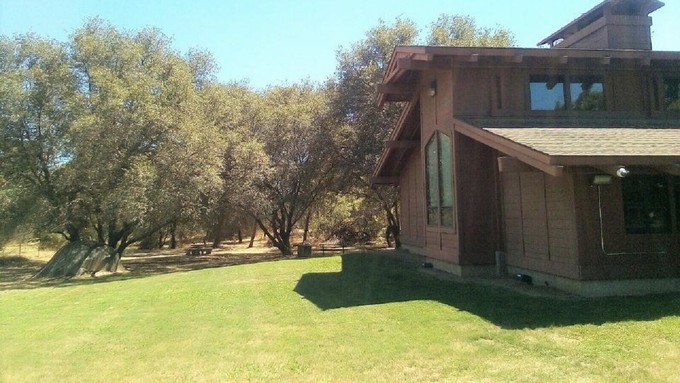
Placer County master gardeners to break ground on 11,000-square-foot project

This area behind the Loomis Library will become the demonstration garden for the Placer County master gardeners. Photo courtesy Loomis Library
A huge asset for Placer County gardeners – plus those from neighboring counties – is one step closer to reality.
On Tuesday morning, Sept. 19, the UC Cooperative Extension Master Gardeners of Placer County will break ground on their own demonstration garden behind Loomis Library. The public is welcome to the 9:30 a.m. ceremony to learn more about the project.
More than a year in the making, the new garden will replace more than 11,000 square feet of lawn with water-wise landscaping plus a demonstration orchard and edible garden.
“In collaboration with the Town of Loomis and the Loomis Library and Community Center, the Master Gardeners will be transforming an existing lawn into a beautiful water-wise garden showcasing California natives, pollinators, and edible plants,” say the master gardeners. “Opportunities for education in the garden will bring a living classroom to the community.”
It takes a community to create such a large new garden, which is being funded mostly via individual donations. The Placer County Water Agency is contributing about $10,000 in rebates and incentives for turf removal and irrigation upgrades. Wood chips and compost for the new garden will be provided by the Town of Loomis.
The Friends of the Loomis Library also are raising money for the garden through their “Buy a Brick” campaign; the engraved bricks will be used in a permanent garden display. You can support the garden by purchasing an engraved brick at https://www.polarengraving.com/floomisl. The bricks cost $120 ($130 with logo).
Or make a contribution directly to the master gardeners at www.pcmg.ucanr.edu.
As its name implies, the new demonstration garden will show how to grow a water-wise and wildlife-friendly garden that looks good year-round while attracting pollinators such as butterflies and bees as well as supporting birds. The garden also will provide space to grow vegetables, fruit, berries and herbs as part of educational displays.
Besides offering a living showcase of the master gardeners’ work, the project will save a significant amount of water by the replacement of all that old lawn. The garden’s design includes places to hold gardening workshops and other events. Signage will identify all the plants and offer tips for home gardeners.
According to library officials, the master gardeners hope to have the first phases of construction including the lawn removal completed in time for fall planting of California natives.
Loomis Library is located at 6050 Library Drive, Loomis.
Comments
0 comments have been posted.Sacramento Digs Gardening to your inbox.
Food in My Back Yard Series
May 6: Maintain soil moisture with mulch for garden success
April 29: What's (already) wrong with my tomato plants?
April 22: Should you stock up on fertilizer? (Yes!)
April 15: Grow culinary herbs in containers
April 8: When to plant summer vegetables
April 1: Don't be fooled by these garden myths
March 25: Fertilizer tips: How to 'feed' your vegetables for healthy growth
March 18: Time to give vegetable seedlings some more space
March 11: Ways to win the fight against weeds
March 4: Potatoes from the garden
Feb. 25: Plant a fruit tree now -- for later
Feb. 18: How to squeeze more food into less space
Feb. 11: When to plant? Consider staggering your transplants
Feb. 4: Starting in seed starting
Sites We Like
Garden Checklist for week of May 4
Enjoy this spring weather – and get gardening!
* Plant, plant, plant! It’s prime planting season in the Sacramento area. Time to set out those tomato transplants along with peppers and eggplants. Pinch off any flowers on new transplants to make them concentrate on establishing roots instead of setting premature fruit.
* Direct-seed melons, cucumbers, summer squash, corn, radishes, pumpkins and annual herbs such as basil.
* Harvest cabbage, lettuce, peas and green onions.
* In the flower garden, direct-seed sunflowers, cosmos, salvia, zinnias, marigolds, celosia and asters. (You also can transplant seedlings for many of the same flowers.)
* Plant dahlia tubers. Other perennials to set out include verbena, coreopsis, coneflower and astilbe.
* Transplant petunias, marigolds and perennial flowers such as astilbe, columbine, coneflowers, coreopsis, dahlias, rudbeckia and verbena.
* Keep an eye out for slugs, snails, earwigs and aphids that want to dine on tender new growth.
* Feed summer bloomers with a balanced fertilizer.
* For continued bloom, cut off spent flowers on roses as well as other flowering plants.
* Add mulch to the garden to maintain moisture. Mulch also cuts down on weeds. But don’t let it mound around the stems or trunks of trees or shrubs. Leave about a 6-inch to 1-foot circle to avoid crown rot or other problems.